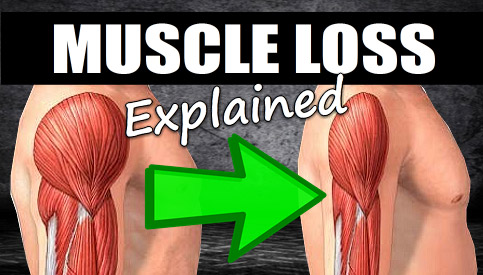HOW LONG DOES IT TAKE TO LOSE MUSCLE AFTER A GYM LAYOFF?

It’s inevitable for every lifter out there – at some point, you’re going to have to take time away from the gym.
Whether it’s due to a hectic period at school or work, a family issue of some kind, or an injury, it’s a virtual guarantee that your training program will be forced to take a backseat in life from time to time.
While it might feel as though all of your hard-earned size and strength gains are about to rapidly waste away the minute your gym layoff begins, fortunately this is not the case.
So, what can you realistically expect to happen during and after a training layoff?
Let’s go over it.
Muscle Loss Explained

How long does it take to lose muscle mass once you stop lifting weights?
The exact time frame will vary from person to person depending on a variety of factors, but assuming your nutrition is adequate (meaning you’re eating roughly around maintenance calories and are consuming sufficient protein), losses in lean muscle mass will generally kick in after about 2 weeks of inactivity.
Remember though, this is just when the process will start, and it’s not as if all your muscle gains are going to instantly fall off your body the second that the 2 week mark hits.
Once muscle atrophy begins to set in, it will still happen at a slow and gradual pace from there forward.
Even after a full 2, 3 or 4 weeks off from the gym, if your diet is reasonably on point, the vast majority of your gains will still be left in tact assuming you’ve been training for a reasonable length of time and have made significant progress up to that point.
In fact, two research studies examined what would happen if lifters took 3 weeks off after every 6 weeks of training and compared the results to a control group that trained continuously.
What the researchers found was interesting: both groups gained the same amount of muscle mass and strength after 15 and 24 weeks. (1, 2)
I’m not recommending that you follow this same training schedule, but the point is that there’s no reason to get overly worried if you’re forced to take a bit of time away.
If all you’re doing is taking a short 1-2 week break from training, it’s more useful to think of it as simply being a “pause” in your program rather than something that’s going to cause you to noticeably regress.
“Why Do I Look Softer And Less Defined During A Layoff?”

While losses in actual dry muscle mass happen at a fairly slow pace, one thing you probably will notice is that your muscles won’t look quite as full or defined as your layoff progresses.
Your physique will probably appear a bit smoother and “flatter” looking, and this might create the impression that you’ve lost a good chunk of lean muscle.
However, this is typically not the result of true lean muscle loss and is instead due to other contributing factors.
The first cause is neurological. When you workout, the activity of your central nervous system (CNS) remains heightened for hours (or even days) after your workout.
Some researchers claim that it takes up to 10 days before your CNS is recovered fully.
When the activity of your CNS remains elevated, your muscle fibers remain slightly more activated, even at rest. This gives you a harder and more “toned” look.
During a layoff, the opposite occurs – your muscle tone decreases slightly due to the lowered CNS activity.
The second reason why your muscles look a bit less defined during a layoff has to do with inflammation.
When you take time off from training, the inflammation you’ve built up in your muscles and tendons decreases. This makes your muscles look less swollen and “looser”.
Lastly, your muscles will also be storing less fluid and glycogen in the tissue due to the period of inactivity, which also has a slight “deflating” effect on your appearance.
Let’s also not forget the psychological side of things either, as it’s very easy to skew your own perception of your body based on your beliefs.
If you simply “feel” smaller and more out of shape as a result of your training layoff, chances are that that’s exactly what you’ll see when you look in the mirror even if the actual objective difference is only very minor.
The Benefits Of “Muscle Memory”

Fortunately, all of the effects described above – both the legitimate muscle loss that will occur after about 2 weeks, and the temporarily “less defined” appearance – will be regained at a much quicker pace once you resume training than it took to originally achieve them the first place.
This process is known as “muscle memory”.
What is muscle memory and how does it work?
Well, the majority of cells in the body contain only one nucleus that regulates most cell functions. Muscle fibers, however, have many muscle nuclei known as “myonuclei”.
When you workout and overload your muscles, new nuclei are added to the muscle cells. Around those new nuclei, smaller “satellite cells” accumulate allowing the muscle to grow larger over time.
The number of nuclei within a muscle fiber is one of the main factors that regulates its size. The more nuclei in a muscle, the more potential for growth.
The key to “muscle memory” is the fact that once those myonuclei are created, they stick around for quite a long time.
How long is not exactly known, but one study on powerlifters who previously used anabolic steroids showed that they still had elevated numbers of myonuclei in their traps 4 1/2 years after they stopped using steroids (3).
That’s why previous steroid use still produces an advantage for muscle growth, and it’s also why bodybuilders and other athletes often get lengthy penalties when they get caught for steroid use.
Another study found that those new nuclei are retained for at least 3 months of inactivity. Hence, it might even be possible that those nuclei remain for the rest of your life to some degree. (4, 5)
The bottom line though is that when you’re forced to take a layoff from the gym, the satellite cells slowly atrophy, but the nuclei remain. The foundation still exists.
This is why you’ll always regain muscle quicker after a layoff, since the smaller satellite cells are rebuilt relatively fast once you start training again.
The Bottom Line On Muscle Loss And Muscle Memory

If you need to take a temporary training layoff for whatever reason, don’t panic.
Your muscles will be alright.
How long does it take to lose muscle once you stop working out? Assuming a half decent diet is in place, you won’t begin losing actual lean muscle until a full two weeks of inactivity have passed.
Even after that, the process will be quite slow and gradual.
The best part is, once you return to the gym, “muscle memory” will allow you to recoup any potential muscle loss you experienced at a fairly quick pace.
Remember: building a great physique is all about what you do over the long term.
Consistency is obviously highly important, but taking small breaks throughout the process is completely normal and won’t be a big deal in the overall picture.
In fact, taking short rest periods here and there may actually improve your progress by giving your body a chance to fully recover and reset both physically and mentally.
If you found this article helpful, make sure to sign up for your FREE custom fitness plan below...




